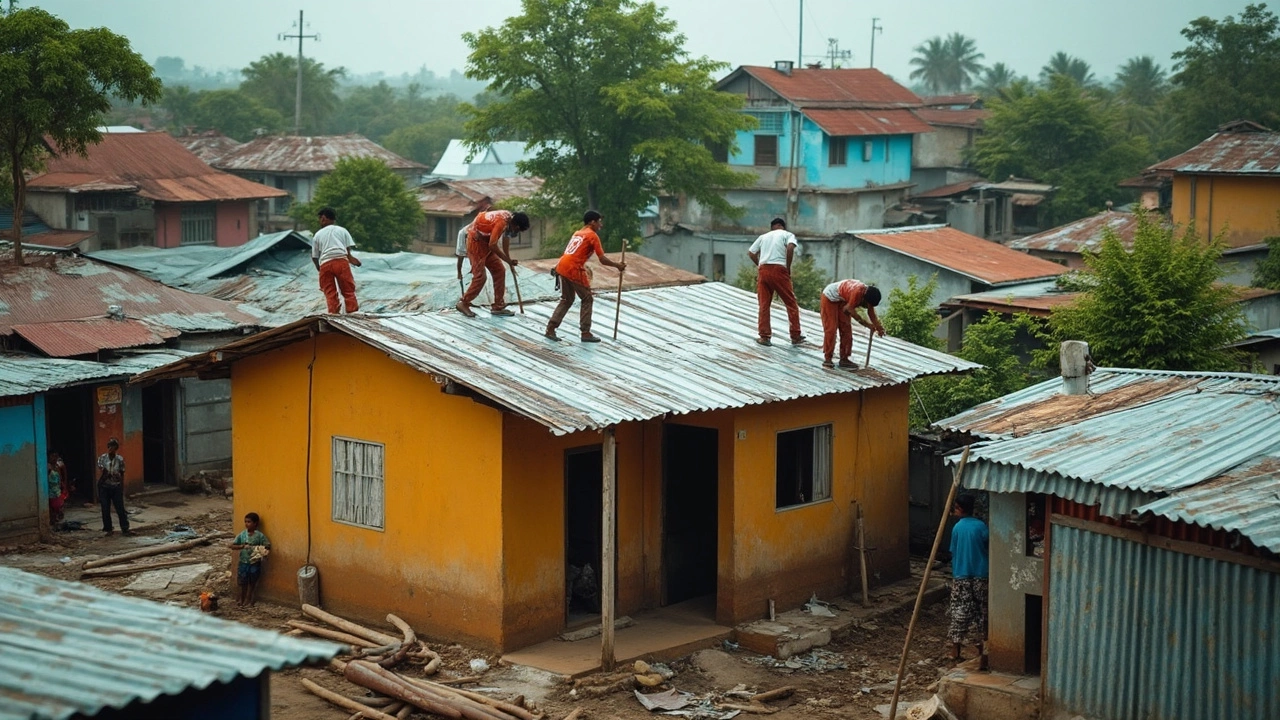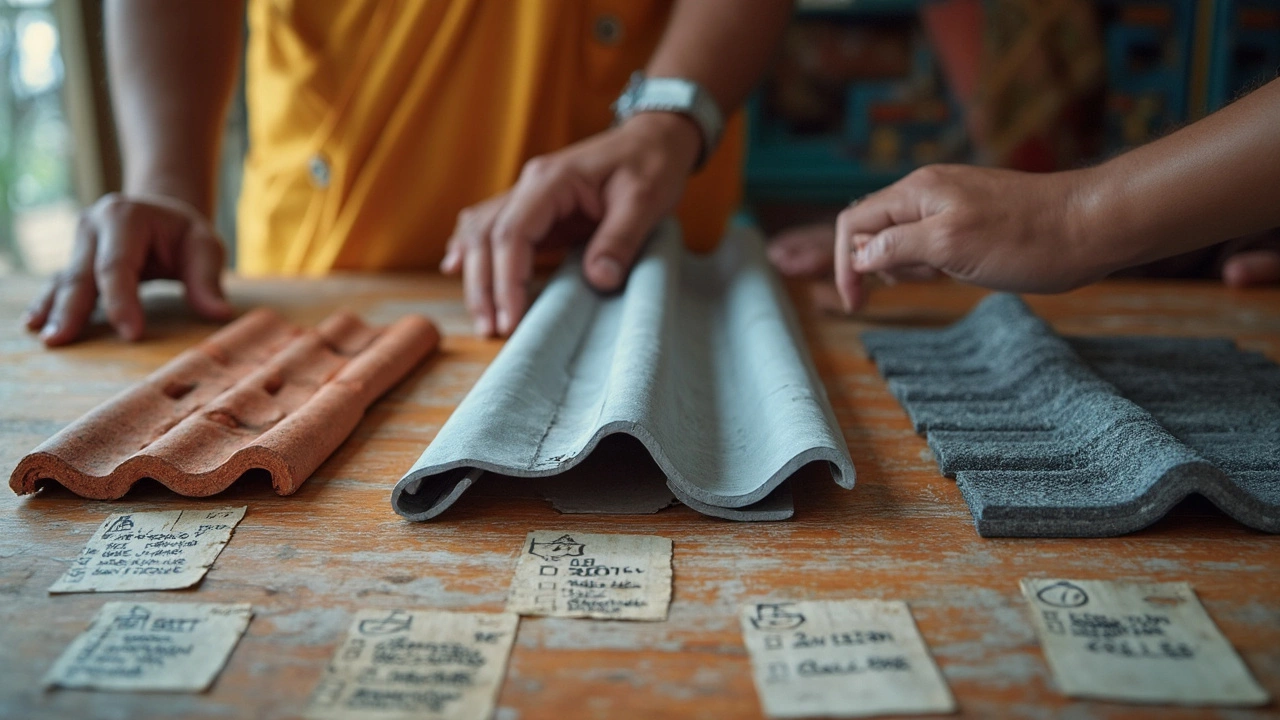Least Expensive Way to Roof a House: Real Savings Without Sacrifice

When everyone’s talking about rising home costs, nobody wants to overspend on their roof. But cheap doesn’t always mean bad—and expensive doesn’t always mean better. The trick is to know where to save, and where saving costs you double later.
Right now, the lowest price tag on roofing usually comes down to two words: asphalt shingles. They're the most used roof material in the country for a simple reason—they offer solid protection for the lowest up-front cost. But not all asphalt shingles are equal, and not every cheap roof keeps its bargain status after five years of leaks.
Metal roofing—believe it or not—can sometimes edge out shingles on value, especially if you plan on staying put for more than a decade. The trick is balancing labor (which can get pricey if you hire the wrong crew) and materials (where going cheap on quality is a big mistake). Did you know that DIY installation could cut your bill in half, but shoddy work can void your warranty and ruin your home insurance? No shame in calling a pro for the heavy stuff.
So, what about other shortcuts, like layering new shingles over the old ones? It saves time and landfill space, but stack too many and your roof sags—and so does your savings when you have to rip everything out and start over. Long story short, going cheap the smart way means learning from the folks who’ve dealt with more repairs than they can count. Ready to skip the mistakes and get straight to the good stuff?
- What Counts as a 'Cheap Roof'?
- Material Breakdown: The Real Winners
- How Installation Affects the Price
- Smart Corners You Should Never Cut
What Counts as a 'Cheap Roof'?
If you’re staring at roof replacement quotes and trying not to panic, knowing what makes up a “cheap roof” can really help. It's not just about paying the lowest upfront price. The cheapest roof should hold up against bad weather, keep your home dry, and last long enough that you aren’t right back at square one five years later.
To really measure what’s cheap, look at the cost per year of service rather than just the total bill. Paying less now for a roof that only lasts a handful of years doesn’t actually save money in the long run.
Here’s a quick snapshot of what “cheap” usually means when comparing materials for a typical U.S. home (about 1,700 square feet):
| Material | Average Cost (2025, per square foot) | Average Lifespan (years) |
|---|---|---|
| Asphalt shingles | $1.25–$2.25 | 15–20 |
| Corrugated metal panels | $2.50–$4.00 | 25–40 |
| Rolled roofing | $1.00–$2.00 | 5–10 |
| Wood shingles | $4.00–$7.00 | 20–30 |
Most folks go with asphalt shingles simply because they win the race for lowest upfront cost. But things like labor rates, shape of your roof, and even your local climate can make a dent in your wallet too.
One big mistake? Skimping on underlayment or flashing, thinking it’s not important. Water sneaks in where it shouldn’t, and suddenly that cheap roof costs way more in repairs.
- Want to save cash? Stick with standard colors and avoid funky roof designs.
- Keep it simple: less roof slope and fewer angles mean lower labor costs.
- Buying basic-class shingles in bulk during spring sales can cut prices even more.
So, a cheap roof is more than just the material—it's the full package: simple design, standard materials, and smart spending on parts that matter for keeping weather out. Chasing the absolute lowest price rarely works out, but a little know-how goes a long way to keeping those roofing numbers down for good.
Material Breakdown: The Real Winners
If you want a roof that’s easy on the wallet, it all starts with picking the right material. Let’s be blunt—some options look cheap up front and turn into money pits, while others give serious bang for your buck. The key is knowing which materials actually hold up and really are the cheap roofing winners over time.
Asphalt shingles are the reigning champ of budget roofing for houses. Even in 2025, no material gets used more for regular homes, especially if you’re watching the bottom line. You’re likely to see prices land between $100 and $120 per square (100 square feet of shingles), plus labor. Stick with basic three-tab shingles if you really want to save—they aren’t fancy, but they last about 12-20 years and do the job.
If you want something that can handle hail or heavy rain better, upgraded architectural shingles cost a bit more but still fit the "affordable" bill. These usually last longer (some brands offer 30-year warranties) and don’t curl up like cheapies. But if you’re fixing up a rental or a shed, three-tabs are hard to beat on price alone.
Corrugated metal roofing might sound like a splurge, but it can actually compete on price—especially if you can install it over an existing roof. Prices for corrugated metal start around $120 per square, but installation is usually faster (less labor). Metal reflects the sun better than shingles, so you might save a bit on cooling bills too. And when properly maintained, these roofs last 40 years easy.
Roll roofing is the bottom of the barrel, price-wise. It’s mainly used for sheds or low-slope roofs, runs about $50 per square, and takes almost no time to slap up. The catch? It can look pretty rough and you’ll be patching it or swapping it out after 5 to 10 years.
Other trendy materials, like synthetic slate or clay tiles, don’t even come close when you’re talking affordability. They just aren’t built for budget projects. Even popular options like wood shakes end up costing more in both install and maintenance.
- If you can, shop locally for materials—delivery charges can wreck a budget fast.
- Check if your city or local supplier has any leftover or "damaged" bundles. Plenty of folks score new shingles for 50% off this way (the damage is often just to the packaging).
- Don’t forget about warranties—cheaper isn’t always a win if you’re covering repairs yourself in five years.
Bottom line: for a regular house with average needs, three-tab asphalt shingles win on price every time. Metal roofs are a close second if you want something longer-lasting. Skip anything that looks too "innovative" unless you want the added headache—or cost.

How Installation Affects the Price
The way your roof goes on can almost double—or slash—the final bill. Paying attention here is the difference between an affordable job and a money pit. With cheap roofing, you have to consider not just the materials, but labor, method, and even timing.
Labor is your number-one variable. In the U.S., hiring professional roofers typically costs anywhere from $2.50 to $5.50 per square foot, depending on the region, roof pitch, and how busy crews are that season. If you're on the West Coast, you might pay 15-20% more than in the Midwest. And steep roofs or hard-to-reach spots? Expect an upcharge, because nobody works for free when it means risk and extra sweat.
| Installation Type | Approx. Cost per Sq Ft (2025) |
|---|---|
| DIY Asphalt Shingle | $0.90 - $1.80 |
| Pro Asphalt Shingle | $2.50 - $5.50 |
| DIY Metal Roof | $2.50 - $4.00 |
| Pro Metal Roof | $5.00 - $12.00 |
People save big going DIY, especially with basic roofs. But there’s a tradeoff: one mistake can lead to leaks and repairs that swallow any savings. Plus, installing metal roofing is tougher than it looks—those panels are heavy, hiding cuts and kinks that amateurs don’t spot until water pours in. And forget about a manufacturer's warranty if you skip the pros.
Looking to save without regret? Here are some smart moves:
- Get multiple quotes. Prices swing a lot, even in the same town. Let roofers know you’re price-shopping for leverage.
- Ask about "tear-off" fees. Layering new shingles over old ones costs less, but this only works if your current roof is in good shape and meets code.
- Book in the slow season. Roofers charge less in early spring or late fall, when jobs are scarcer.
- Avoid complex designs. Valleys, peaks, and dormers mean more labor. Simpler shapes cost less every time.
Bottom line: the cheapest installation comes down to balancing what you can tackle yourself, how much risk you’re willing to take, and the hidden costs of cutting too many corners.
Smart Corners You Should Never Cut
It’s tempting to squeeze every dollar when chasing a budget-friendly roof, but some shortcuts blow up fast. Want your cheap roofing plan to actually save money? Steer clear of these disasters.
- Cheap Roofing Material Quality: Yes, the goal is saving, but don’t buy the absolute bottom-of-the-barrel shingles. Ultra-low-end shingles can peel, curl, and lose color in just a few years—sometimes half the lifespan of a mid-range product. Stick with Class A fire-rated shingles, and check that they’re rated for your local climate.
- Skipping the Underlayment: That thin waterproof layer under the shingles might not look like much, but it’s your backup when storms get wild. Skipping, or using poor underlayment, is the easiest way to end up with rot or mold in your attic.
- Improper Ventilation: Roofs need to breathe. Without enough vents, heat and moisture get trapped, warping wood and frying shingles from underneath. This is a top cause of early roof failure. Mind local code on venting—it’s not just red tape.
- Poor Fastening: Using too few nails (or the wrong kind) saves pennies now but comes back hard. Shingles can blow off in the first windstorm if they’re not installed right. There’s a reason most shingle brands require at least four to six nails per shingle in their warranties.
- Bad Flashing Work: Flashing—the metal bits around chimneys, valleys, and roof edges—keeps water out of places it shouldn’t be. Gaps or reused flashing are water entry points, period.
See how these details play out for your wallet? Check the table below for common mistakes and typical repair costs people end up facing later:
| Short Cut | Typical Repair Cost (USD) | Time Until Problem |
|---|---|---|
| Cheap Quality Shingles | $2,500–$4,000 (partial re-roof) | 3-7 years |
| No/Bad Underlayment | $1,800–$5,000 (rot repair, re-roof) | 2-5 years |
| Lack of Ventilation | $2,200–$6,000 (deck repair) | 5-10 years |
| Poor Fastening | $300–$2,500 (patchwork, replacements) | First strong storm |
| Iffy Flashing | $400–$1,300 (leak repairs, damage behind walls) | 1-3 years |
Trying to cut corners with these steps never pays off. Spend a bit more up front on these parts, even when you’re going budget on the rest, and your roof stops being a money pit. You get what you pay for, but you only have to pay once if you get it right the first time.
Write a comment